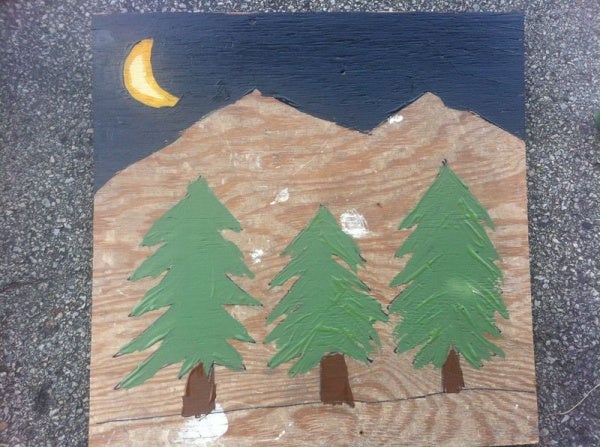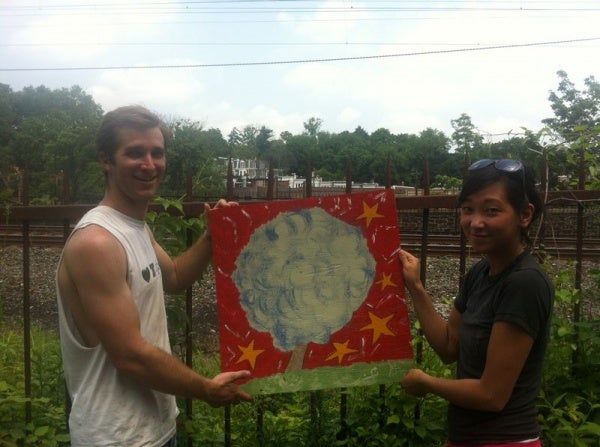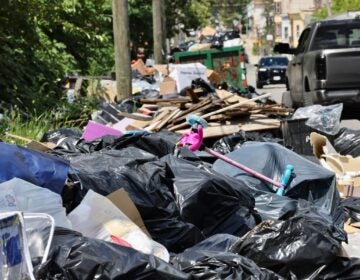‘Bloccupy’ effort seeks to improve Wister Station area in Germantown
With shovels and paint brushes in hand, Germantown neighbors celebrated their holiday weekend with hot dogs, music and an intent to clean up Rufe Street, the known problem roadway that leads to the Wister Station regional-rail stop.
They deemed Saturday’s event a “Bloccupy Party” — a spin on the Occupy movement — to show the community that the pathway is watched over by caring neighbors working to see an end to dumping on the site and make it a pedestrian-friendly street.
“We want to make it feel like it’s being used and make it more welcoming,” said Baynton Street resident Corrie Spellman.
Their efforts included attempting to level-off the long ditch that runs along Rufe Street and to adorn the fence that lines the train-track side of the street with artwork.
Ross Hennesy is spearheading the efforts.
“There was a group of people here who worked on this area long ago,” the Baynton Street resident said. “They were called the Baynton Hill Neighbors, but as people got older or moved away, that fell apart.”
He said neighbors are considering naming their initiative the “Friends of Wister Station.”
Growing support
The station has already seen some support from SEPTA officials, the Streets Department and City Council.
Within the past year, a yield sign, stainless-steel safety and security mirrors and a high-resolution solar-powered mobile camera have been installed. (The camera is a part of City Council’s work to fight illegal dumping throughout the city.)
“We’ve had some responsiveness,” said Hennesy. “We’re really hoping for a sidewalk here, but if they won’t do it, we’re at least trying to level-off the ditch.”
Weavers Way Co-op donated the food at the event and its general manager, Glenn Bergman, worked the grill. He said he supports the initiative because he owns a building on nearby Baynton Street.
“This area is historic for dumping and drugs,” said Bergman, “We’re here to occupy it a little. It’s bringing people together.”
Art as tool for change
To make the area more pedestrian-friendly, the group enlisted the help of Alex Cook, a mural artist and friend. At the event, the group painted small pieces of plywood that Cook had sketched a variety of images onto including nature scenes and patterns.
“We just asked everyone to bring out some leftover paints,” said Hennesy, “and we had about 20 pieces of scrap plywood that we cut into squares.”
He purchased $20 worth of hose clamps out of his own pocket to attach the artwork to the iron fence that sits along the train-track side of Rufe Street. He said it’s all worth it if it can make a difference.
Why they care
Hennesy and many others at the event were also a part of the Philly Spring Cleanup event in April on the East Bringhurst Street side of the station, which has been a dumping ground for trash, wood, bricks, tires and broken glass.
For this cleanup, Hennesy distributed flyers on nearby streets in an effort to enlist the help of neighbors.
Matt McFarland, a Coulter Street resident, uses the station on a daily basis. He said he has seen multiple abandoned-car fires on the street and has reported incidents and written letters to City Council.
“There’s no accountability,” said McFarland. “It’s a confluence of one-way streets and no one lives on this section. They can get away with anything. There’s a high chance that you can get jumped or mugged here. We’re trying to make it safer.”
Andrea Morales, who has lived on Queen Lane since 1963, said she recalls a stairway leading to the station platform being taken out due to drug users and dealers loitering the steps.
“When my kids were young, we used to take the train every day,” said Morales, “but when they took the stairway out, we had to take this [Rufe] street, but it wasn’t lit up like the stairway was. I’ll be glad to see it improve.”
Claudia Coons, a fellow 40-year Queen Lane resident, agreed.
“It has needed lights,” said Coons. “I’d like to see them put in a sidewalk.”
Why they question
However, Penn Street resident Larry Roy said he was skeptical of the group’s efforts. He has concerns that a sidewalk will cost the community too much.
“If they raise our taxes to put in a sidewalk, then it’s not worth it,” said Roy. “I’ve seen changes come and go here. Really, it’s the government who doesn’t want to do much because they’re not getting money from the neighborhood.”
WHYY is your source for fact-based, in-depth journalism and information. As a nonprofit organization, we rely on financial support from readers like you. Please give today.










